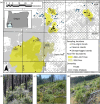Distinct bird assemblages emerge after fire versus forest harvest but converge with early seral forest development
- PMID: 40545630
- PMCID: PMC12183351
- DOI: 10.1002/eap.70032
Distinct bird assemblages emerge after fire versus forest harvest but converge with early seral forest development
Abstract
Anthropogenic changes to disturbance regimes, including intensified forest management, have been hypothesized to drive population declines in early seral forest birds. Species adapted to early seral conditions can benefit from timber harvest, but intensively managed stands often lack key habitat features that exist after natural disturbances. To evaluate how early seral bird communities differ between areas regenerating from natural (i.e., wildfire) and anthropogenic (i.e., timber harvest) disturbance, we sampled stands across a chronosequence of 2-20 years post-disturbance in southwest Oregon, USA, in sites regenerating after wildfire, clearcut harvest with intensive management, or post-fire salvage logging. We found that fire-origin stands supported 8.8 more species (90% CI: 4.1, 14.1; 54% more) than clearcut stands immediately following disturbance (2-5 years), including a greater number of cavity-nesting species. These differences diminished somewhat with stand age, but fire-origin stands still supported 4.9 more foliage-gleaning species (90% CI: 3.2, 6.5; 102% more) 6-9 years after disturbance. Differences in species richness and composition between disturbance types attenuated as stands approached canopy closure (16-20 years), suggesting that intensive management may emulate natural stand-replacing disturbance for birds that occupy developmentally advanced early seral forests. Salvage-logged stands exhibited few differences from unlogged fire-origin stands, although they supported 1.8 fewer (90% CI: 0.0, 3.4) cavity-nesting species 6-9 years after fire. Overall, distinct bird communities in recently burned forests suggest that these areas may be especially valuable for promoting biodiversity. Guilds more strongly associated with recently burned forests than harvested stands tended to be associated with biological legacies, including deciduous shrub cover, large residual trees, and snags. Therefore, emulating post-fire structural legacies and early seral vegetation in managed forests should enhance their value for birds, including species experiencing long-term declines.
Keywords: Klamath Mountains; Oregon; avian point counts; bird community composition; clearcut; early successional forest; intensive forest management; occupancy modeling; post‐fire salvage logging; species richness; wildfire.
© 2025 The Author(s). Ecological Applications published by Wiley Periodicals LLC on behalf of The Ecological Society of America.
Conflict of interest statement
Andrew J. Kroll was employed by Weyerhaeuser Company, one of the landowners in this study, at the time the research was conducted. Neither the landowners nor the companies that indirectly funded this work influenced the study design, data analysis, interpretation, or decision to publish.
Figures





Similar articles
-
Identifying and managing disturbance-stimulated flammability in woody ecosystems.Biol Rev Camb Philos Soc. 2024 Jun;99(3):699-714. doi: 10.1111/brv.13041. Epub 2023 Dec 17. Biol Rev Camb Philos Soc. 2024. PMID: 38105616 Review.
-
Divergent trajectories of regeneration in early-successional forests after logging and wildfire.Ecol Appl. 2025 Jan;35(1):e3061. doi: 10.1002/eap.3061. Epub 2024 Nov 20. Ecol Appl. 2025. PMID: 39564765
-
Disturbance gradient shows logging affects plant functional groups more than fire.Ecol Appl. 2016 Oct;26(7):2280-2301. doi: 10.1002/eap.1369. Epub 2016 Sep 20. Ecol Appl. 2016. PMID: 27755744
-
Unprecedentedly high global forest disturbance due to fire in 2023 and 2024.Proc Natl Acad Sci U S A. 2025 Jul 29;122(30):e2505418122. doi: 10.1073/pnas.2505418122. Epub 2025 Jul 21. Proc Natl Acad Sci U S A. 2025. PMID: 40690667 Free PMC article.
-
Resolving conservation conflict through fire refugia: Integrating landscape resilience into forest management.J Environ Manage. 2025 Aug 14;393:126974. doi: 10.1016/j.jenvman.2025.126974. Online ahead of print. J Environ Manage. 2025. PMID: 40816141 Review.
References
-
- Agee, J. K. 1993. Fire Ecology of Pacific Northwest Forests. Washington, DC; Covelo, CA: Island Press.
-
- Arnett, E. B. , Kroll A. J., and Duke S. D.. 2010. “Avian Foraging and Nesting Use of Created Snags in Intensively‐Managed Forests of Western Oregon, USA.” Forest Ecology and Management 260: 1773–1779.
-
- Attiwill, P. M. 1994. “The Disturbance of Forest Ecosystems: The Ecological Basis for Conservative Management.” Forest Ecology and Management 63: 247–300.
-
- Baig, J. , and Gavin D. G.. 2023. “Postglacial Vegetation and Fire History with a High‐Resolution Analysis of Tephra Impacts, High Cascade Range, Oregon, USA.” Quaternary Science Reviews 303: 107970.
-
- Balmford, A. 1996. “Extinction Filters and Current Resilience: The Significance of Past Selection Pressures for Conservation Biology.” Trends in Ecology & Evolution 5347: 193–196. - PubMed
MeSH terms
Grants and funding
LinkOut - more resources
Full Text Sources
Medical

